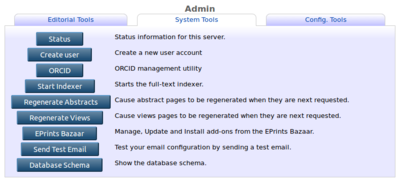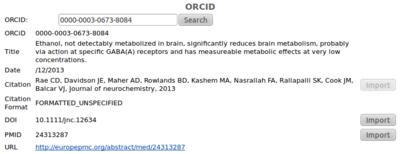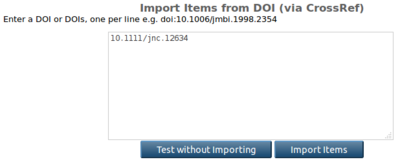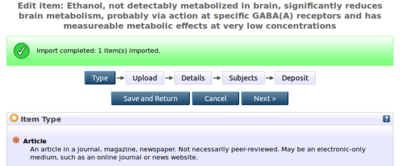Difference between revisions of "Import From ORCID"
(→Overview) |
(→Technical Details) |
||
| Line 7: | Line 7: | ||
== Technical Details == | == Technical Details == | ||
| − | Given an author's ORCID, the plugin queries the | + | Given an author's ORCID, the plugin queries the ORCID Tier 1 API and retrieves a list of works published by that author in JSON format. |
The metadata describing each work may include a ''work-citation-format'' (for example, BIBTEX) and/or multiple ''work-external-identifier-type'' (for example, DOI, PMID) elements - where the ''work-citation-format'' or ''work-external-identifier-type'' can be mapped to an EPrints import plugin an Import option is displayed next to the work. | The metadata describing each work may include a ''work-citation-format'' (for example, BIBTEX) and/or multiple ''work-external-identifier-type'' (for example, DOI, PMID) elements - where the ''work-citation-format'' or ''work-external-identifier-type'' can be mapped to an EPrints import plugin an Import option is displayed next to the work. | ||
Revision as of 10:54, 14 March 2014
Overview
Import from ORCID is a simple plugin for EPrints that allows you to import publications for a given author identified by an ORCID.
The plugin demonstrates how an EPrints repository can interface with the ORCID Tier 1 (public) API.
Technical Details
Given an author's ORCID, the plugin queries the ORCID Tier 1 API and retrieves a list of works published by that author in JSON format.
The metadata describing each work may include a work-citation-format (for example, BIBTEX) and/or multiple work-external-identifier-type (for example, DOI, PMID) elements - where the work-citation-format or work-external-identifier-type can be mapped to an EPrints import plugin an Import option is displayed next to the work.
User Guide
1. After installing, an ORCID button appears on the Admin screen.
2. Enter an author's ORCID to search for their published works.
3. Search results retrieved and listed with import options where available.
4. Clicking Import takes you to the default EPrints import screen.
5. After importing the item, you are taken to the deposit workflow where you can edit and deposit the item.




